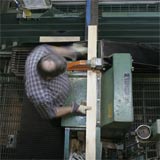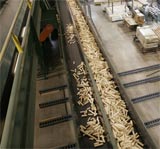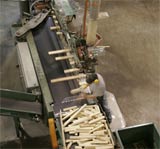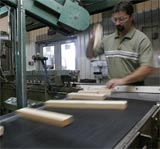Finger Jointing

The finger jointing process takes pieces of wood called blocks and joins them together. This involves two additional steps. First any unacceptable wood deformities must be cut out of the lumber “rips’ by cross-cutting these out at the “cut-line”.
The remaining strips or blocks of clear wood are then passed through a finger jointer which cuts out small male and female fingers into the ends of the wood pieces. Trees do not always grow to long lengths that are typically required for mouldings and some production processes develop shorter peices of wood we must collect and save these smaller pieces for use in the finger jointing process.
Finger Jointing is type of joint; much like a splice joint, butt joint, or 45 degree mitre joint. As per below:
-

Splice -

Butt -

Finger -

45 Degree Miter Joint -

Dado
Finger Jointing is utilized because of the strength of the joint that it creates by the many contact points created by the fingers. This gives the water based adhesive Alexandria Moulding uses to create a fast secure bond.
To manufacture this joint, wood is optimized at our cut line where skilled employees scan the wood and stream the wood pieces into conveyor belts where the wood pieces of sufficient quality will be used in the for finger jointing process. This involves cutting out knots, bark, an other wood deformities.


From this point the cut pieces are sent via conveyor belt to have finger joints cut into both ends of the wood. A male and female joint is precision cut into the wood.
Directly after flowing through the conveyor belt a water based adhesive is applied to the male and female ends and they are joined together with a hydraulic press to maintain a satisfactory interlocking of the fingers. Before they are sent through one further quality control check is made on the finger jointed pieces to ensure they meet our standards.
After the finger jointing process is completed, these finger jointed blocks are usually resawn and transformed into blanks ready for the moulders.


